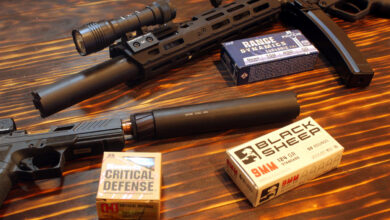The .32 Caliber: Will It Ever Succeed?

In the United States, there has been a variety of great firearm cartridges that have come and gone. Most were replaced by newer, better rounds, but some never deserved their demise. There have been a ton of .32 caliber handgun cartridges that are largely forgotten today by the general public. Several old and modern .32 caliber cartridges either faded away or never took off.
Did they deserve to take off? Surely, they weren’t all great, but there was a handful of .32 caliber cartridges that are excellent and deserve a place in the conversation of modern handgun calibers, specifically defensive calibers. Every time the .32 comes up, it is often ignored, and for what’s often explainable and understandable reasons. Other times, it is due to a particular American attitude I’ll talk more about later.
I’m a fan of the .32 caliber as a pistol round and feel it gets a bad rap. Some .32 caliber rounds offer numerous advantages over alternative cartridges. This is especially true when it comes to smaller, pocket-sized pistols.
.32 ACP Vs. The World
Typically, the benefits of the .32 are often overlooked. For many casual shooters, the lack of .32 caliber guns makes it tough to get into the various .32 cartridges, which means the benefits are not experienced enough to be appreciated. The .32 caliber offers benefits in both automatics and revolvers compared to more standard self-defense loads. I consider the standard self-defense cartridges to be 9mm, .380 ACP, 40 S&W, 45 ACP, .38 Special, and .357 Magnum.
In terms of .32 caliber self-defense cartridges, we have four main options and one extra we’ll toss in for fun. The three main options are .32 ACP, .32 H&R Magnum, .327 Federal Magnum, and .30 Super Carry. I understand .30 is in the name, but the actual projectile is a .312 inch, the same as the .32 H&R Magnum, .32 ACP, and .327 Federal Magnum. It turns out most .32 calibers are .31 caliber and some change. Our extra round is the .32 S&W Long, which is also a .312 caliber projectile.
Benefits of the .32 Caliber
The benefits these .32 caliber projectiles offer over others include higher capacity. The .32 ACP cartridges are small, and you can pack a ton into very short single-stack magazines. With the .30 Super Carry, we get +2 rounds compared to 9mm. The various .32 revolver cartridges contain an extra round when compared to .357/.38 rounds.

Another benefit is lower recoil or lowerish recoil. .32 ACP has 50% of the recoil force of .380 ACP. The hot-rodded .327 Magnum feels downright soft compared to a .357 Magnum cartridge. Admittedly, rounds like the .30 Super Carry feel about even with their 9mm counterpart.
The 7.65mm projectile must be just perfect in size for some reason. I can’t say why exactly, but the varied .32 caliber cartridges are very well-known for their accuracy. The .32 S&W Long is used by Olympic Bull’s eye shooters in semi-auto handguns for that very reason. The .32 ACP is surprisingly accurate and easy to shoot, and the .327 Federal Magnum was accurate enough that Henry decided it needed a rifle to handle it.

The gun, the shooter, and even the accessories can affect firearm accuracy. The .32 caliber projectiles just tend to do their job very well and arguably better than their counterparts.
Ballistic Concerns
There are some concerns about the ability of a .32 caliber cartridge to stop a threat. Plenty of people will pull out energy tables and talk about small bullet sizes but completely ignore what matters. What matters is shot placement and penetration. Handgun projectiles stop a threat through their ability to reach something vital.

When a handgun hits a threat, the only damage it does is the tissue disrupted by direct contact with the bullet. The bullet needs to reach something vital, and the shooter needs to be able to place their round there. The use of jacketed hollow points allows for expansion, but not every .32 caliber cartridge should be paired with hollow point ammunition. Hollow points make the rounds expand, which can create drag and prevent deeper penetration.

Calibers like the .32 ACP and .32 S&W Long are better suited to use FMJ ammo to ensure adequate penetration. Calibers like the .327 Federal Magnum, .30 Super Carry, and .32 H&R Magnum are moving fast enough to make use of jacketed hollow points and benefit from expansion.
With the .32 ACP and .32 S&W Long, we aren’t getting super fast-moving rounds. They are about equal in velocity and weight and typically won’t over-penetrate with FMJs. Most .32 ACP guns don’t handle JHPs well. They are semi-rimmed cartridges, and the rim can cause rim-lock if the projectiles are shorter than the standard .32 ACP overall length.
Why It Won’t Succeed?
There are several reasons why I don’t think the market will ever accept the varied .32 caliber cartridges. At least the American market won’t accept the .32 caliber cartridges. There are fields filled with Europeans who’d been shot with the .32 ACP and didn’t make it home when their various monarchs declared war on each other.
The main reason for this is the price of the ammo. We love our 9mm because it doesn’t break the bank, and we can find it everywhere. For guns, roughly P365 sized and up, 9mm is one of the better ballistic choices. The .30 Super Carry compares, but costs at least double what 9mm does.

Additionally, availability isn’t always common for every .32 caliber round. I can walk into any gun store and find 9mm, 38 Special, etc., but I won’t always find it.32 ACP, much less .327 Federal Magnum, .32 H&R Magnum, .32 S&W Long, etc. Heck, I find 10mm to be more common than any .32 cartridge.
There is a lack of modern firearms that chamber these cartridges as well. Off the top of my head, I only know of guns like the KelTec P32, the S&W Shield, the S&W EZ, the Ruger LCR, and the new S&W Lipsey’s exclusive 432 that chamber the various .32 caliber rounds.
Bigger Is Better
Finally, we also have the American attitude for small cartridges. When it comes to handguns, we aren’t that far away from an era where if it wasn’t .45 ACP it won’t ever stop a threat. The Colonel Coopers and his crew were quite successful in explaining the benefits of big bore rounds, and this left a lot of great rounds ignored and underappreciated.

While I don’t think the .32 caliber rounds would be the best-duty cartridges, they are great for small guns and concealed carry. That American bigger is better attitude is why guns like the Ruger LCP use the .380 ACP instead of the .32 ACP. The .32 ACP would offer a similar ballistic performance with half the recoil impulse.
We want small guns in big calibers, even when it doesn’t make sense. Ultimately, my dreams of the .32 calibers being common enough to be cheap and plentiful, with a variety of weapons to choose from, are unlikely to come true. I’m a dreamer. What can I say? Still, I plan to do my part and get the new S&W 432 and pay out the ear for .32 H&R Magnum because, dang it, I’m a believer!
The post The .32 Caliber: Will It Ever Succeed? appeared first on The Mag Life.
Read the full article here






